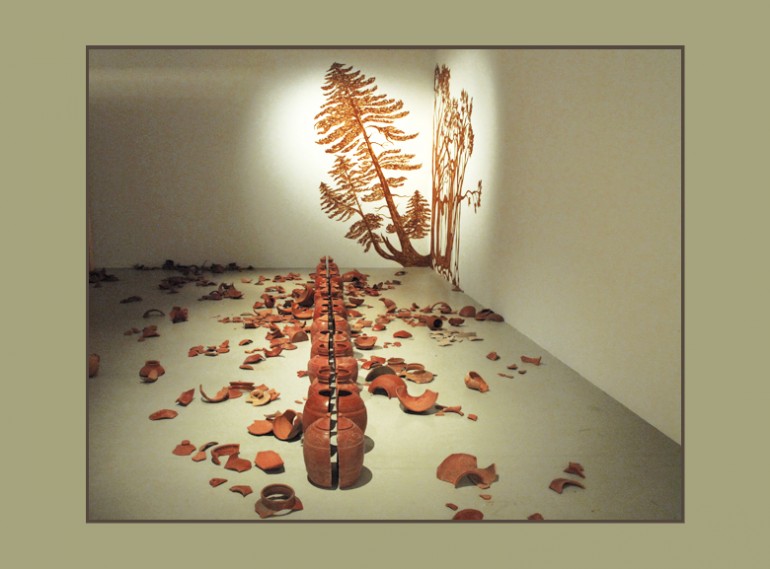Reena Saini Kallat
– Artist’s Website –
2010. Red earthenware, henna, 9 min single channel audio loop.
Not much in terms of effective policy came out of the 2009 climate conference in Copenhagen, or COP15. One figure, though, came to the forefront of most greenhouse-gas reduction conversations at COP15, and that is two degrees.
Two degrees, most reputable scientists agree, is the maximum rise in temperature that we can allow, after which the climate change associated with global warming becomes potentially catastrophic. Another, equally integral relationship is also measured in degrees, where social theorists estimate that every person on the planet is six degrees or six relational steps away from every other person. But for those who share a common civilization history, could the degrees of separation be as narrow or as wide as the river that flows between them?
Rivers have always played an important role in human history. They have been the cradle of great civilizations, the link between cultures, the boundaries of empires, the best means of transportation for trade and, at times, a barrier to invaders. And so it has been with the Indus. It is a river that gave its name to a sub-continent. Since the founding of India and Pakistan as separate states in 1947, the dispute over who should control Kashmir has been amongst the world’s most enduring and violent conflicts. One of the many reasons behind the dispute over Kashmir is water. Kashmir is the origin point for many rivers and tributaries of the Indus River basin feeding Pakistan and India. The water dispute can be traced to the time when the British Indian Empire was partitioned. The split gave India control of the part of Kashmir that is the source of six rivers that irrigate crops in Pakistan’s agricultural heartland of Punjab province and elsewhere. Under the 1960’s International water sharing treaty, Pakistan has the use of the three western rivers – the Indus, Jhelum and Chenab – and India, the three eastern ones – the Sutlej, Beas and Ravi.
The Indus River Basin spanning 1,800 miles, the river and its tributaries together make up one of the largest irrigation canals in the world. The basin provides water to millions of people in northwestern India and Pakistan. Dams and canals built in order to provide hydropower and irrigation have dried up stretches of the Indus River. Water projects have further caused the displacement of people and have contributed to the destruction of the ecosystem in the Indus plain.
Even as I make my piece titled ‘2 Degrees’ with all these varied thoughts in my mind and place it within the context of this first Asian Pacific Biennale of River System titled “The Rising…”, due to the heavy intensity monsoon, the river Indus has overflowed into its floodplain in Punjab and Sindh provinces as authorities evacuate thousands of residents in Sukkur and other cities. Due to the population growth, the people are today living in the alluvial flood plains which used to be left for the river to meander about. Today the river is angry, changing its course and as it flows down, it engulfs many of the populated areas






